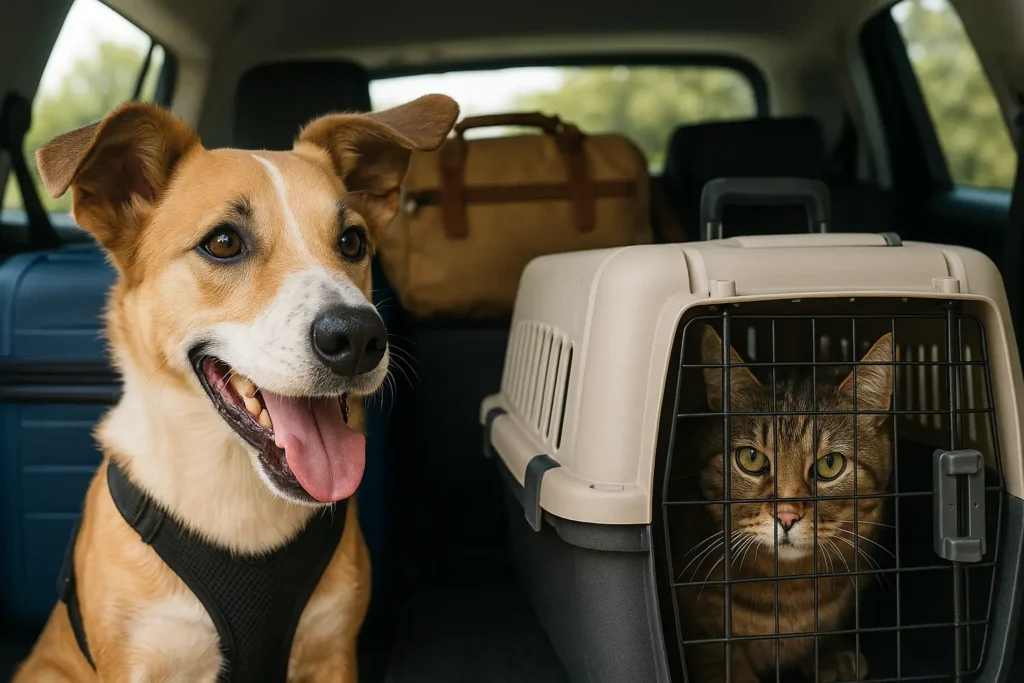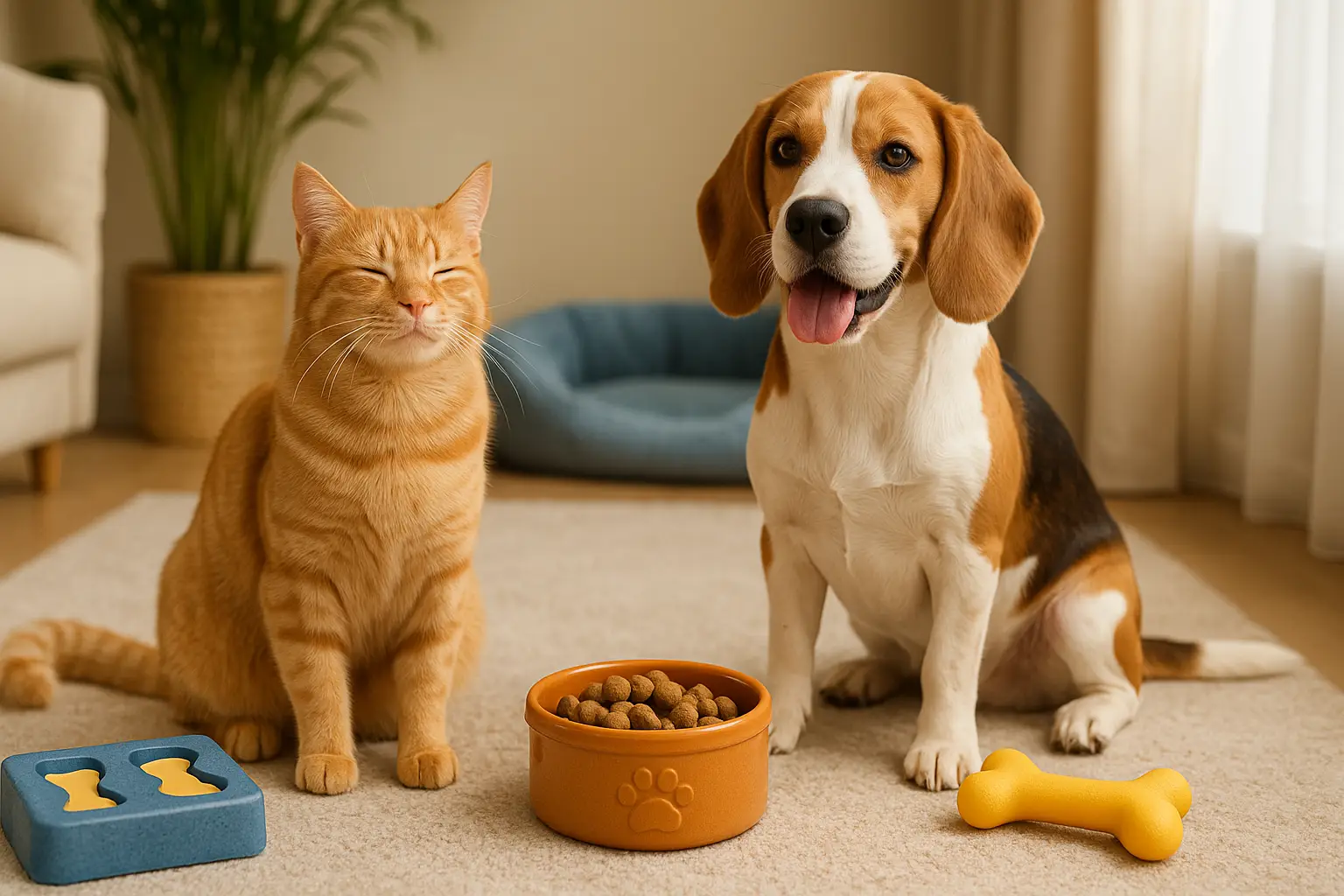How to Travel with Your Pet Without Stress
Whether it’s a road trip, a family visit, or a cross-country move, traveling with pets can be a joyful experience—or a chaotic one. Dogs and cats are highly sensitive to changes in routine, environment, and sensory input. But with the right preparation and mindset, you can turn travel into a positive, stress-free adventure for both of you.
In this guide, we’ll cover the emotional, logistical, and practical elements of traveling with pets, so you can hit the road (or sky) with calm, confidence, and care.

Why Travel Is Stressful for Pets
Even short trips disrupt your pet’s daily rhythm. They’re surrounded by unfamiliar smells, sounds, surfaces, and people.
Common Pet Reactions During Travel:
- Whining or barking
- Hiding or freezing
- Drooling or vomiting
- Excessive panting
- Refusing to eat or drink
- Clinginess or withdrawal
Understanding their stress response allows you to plan with empathy.
Step 1: Know Your Pet’s Travel Personality
Not every animal is a natural traveler. Some adapt easily; others need more preparation.
Travel Personality Types:
- The Explorer: Excited by new sights and smells. Needs guidance, not force.
- The Nervous Nester: Prefers routine. May panic if unprepared. Needs gradual exposure.
- The Watchful Observer: Quiet but alert. May freeze but adapt if given space.
- The Vocal Reactor: Barks or meows constantly under stress. Needs reassurance and distraction.
Adjust your preparation strategy to match your pet’s style.
Step 2: Prepare at Home Before You Go
The smoother the departure, the calmer the journey.
Do This 1–2 Weeks Before Travel:
- Get your pet used to the carrier or car with short daily sessions
- Pack and bring out luggage early so it doesn’t signal panic
- Practice crate time, leash time, or sitting calmly in the car
- Confirm ID tags and microchip info are current
- Prepare medications, food, and travel documents
Familiar routines reduce travel anxiety dramatically.
Step 3: Create a Travel Checklist for Essentials
Being well-packed makes the journey smoother for everyone.
Travel Kit for Pets:
- Food and collapsible bowl
- Bottled water and travel bottle
- Leash/harness/collar
- Bedding or familiar blanket
- Waste bags or litter/litter box
- ID tags and copies of medical records
- Medications or calming aids
- Toys or chews
- Pet wipes or towel
- Carrier or crate
- Portable fan or cooling mat (for warm climates)
A familiar smell (like a used t-shirt) can help soothe your pet on the road.
Step 4: Car Travel Preparation
Most pets will travel by car—safely managing the environment is essential.
For Dogs:
- Use a crate, seatbelt harness, or car barrier
- Don’t allow roaming or lap-riding
- Offer light food before travel (avoid big meals)
- Schedule stops every 2–3 hours for potty and water
- Never leave dogs alone in a car on warm days
For Cats:
- Use a secure, well-ventilated carrier
- Line with a familiar towel or soft pad
- Cover with a light blanket if overstimulated
- Offer quiet music or silence
- Avoid opening windows near your cat’s carrier
Car training is best done in small steps before long trips.
Step 5: Air Travel Considerations
Flying is intense for pets. Know airline policies and your pet’s limits.
Before Booking:
- Confirm pet size and carrier dimensions for in-cabin travel
- Ask if your pet qualifies for cabin vs. cargo
- Understand breed restrictions (short-nosed dogs/cats often can’t fly cargo)
- Avoid flights with tight layovers or extreme temperatures
Day of Travel:
- Feed lightly 4–6 hours before flight
- Use a soft-sided, airline-approved carrier
- Line carrier with absorbent pads
- Label carrier with name, phone, destination
- Carry documents, vaccine proof, and ID photos
Avoid sedation unless advised by a veterinarian—it can interfere with breathing at altitude.
Step 6: Create a Travel Routine for Calm
Structure and rituals provide emotional anchors during travel.
Ideas:
- Use a calm cue before loading the car (“Let’s go for a ride”)
- Create a bathroom routine before departure
- Offer a chew or puzzle toy while in motion
- Pause for water and soft praise at intervals
- Use a calm bedtime routine at the hotel or rest stop
Repeat familiar behaviors to reduce uncertainty.
Step 7: Choose Pet-Friendly Accommodations
Whether you’re staying overnight or settling in for weeks, your pet needs a safe, welcoming environment.
Look For:
- Pet policy and any fees upfront
- Nearby grass or walkable areas
- Quiet rooms away from elevators or lobbies
- Option to leave your pet alone safely (if needed)
At Check-In:
- Set up their bed or carrier immediately
- Let them explore one room at a time
- Keep food and water in the same spot
- Avoid overwhelming them with new stimuli
Make the space feel like a “home away from home.”
Step 8: Keep Meals, Medication, and Exercise on Schedule
Travel doesn’t mean routine disappears.
Stick To:
- Normal feeding times
- Usual food and treats (avoid sudden diet changes)
- Bathroom or litter box rituals
- Medication doses (set reminders)
Even if time zones shift, try to adjust gradually—not all at once.
Step 9: Help Your Pet Adjust to New Surroundings
The first 24–48 hours in a new location are the most sensitive.
Tips:
- Walk them on a leash, even in fenced yards, until acclimated
- Place beds or carriers in quiet corners
- Use scent from home (blanket, toy, shirt) to soothe
- Observe for signs of overstimulation or hiding
- Allow extra rest—they’ll be more tired than usual
Let them set the pace for engagement.
Step 10: Protect Your Pet’s Safety on the Road
New places present new risks. Be proactive.
Stay Aware Of:
- Local wildlife or stray animals
- Toxic plants or unsafe terrain
- Off-leash dogs
- Lost-pet risks in unfamiliar neighborhoods
- Travel illnesses or parasites (ask your vet about preventives)
Keep a leash, ID, and plan ready for any emergency.
Step 11: Practice Travel Hygiene
Travel increases exposure to dirt, stress, and messes.
Hygiene Tips:
- Clean paws after outdoor stops
- Wipe carriers or crates daily
- Use pet-safe wipes for face and coat
- Clean water and food bowls nightly
- Keep bedding dry and fresh
Clean pets are healthier—and calmer.
Step 12: Plan for Downtime and Recovery
Even fun trips are exhausting. Your pet will need decompression time.
Post-Travel:
- Keep activity low for 24 hours
- Resume full routine slowly
- Watch for signs of fatigue, digestive upset, or anxiety
- Offer extra hydration and sleep space
- Reinforce normal behavior with calm affection
Let their nervous system reset gradually.
Step 13: Be Prepared for the Unexpected
Sometimes, travel plans change. Be ready.
Pack an Emergency Kit:
- Vet contact info
- Vaccination records
- List of nearby emergency clinics
- Portable crate
- Extra leash, tags, and collar
- Flashlight, first aid supplies, pet-safe cleaning wipes
Better safe than stressed.
Step 14: Travel with Empathy, Not Just Efficiency
Rushing, yelling, or over-controlling creates more fear.
Instead:
- Speak slowly and kindly
- Pause when your pet freezes or resists
- Adjust your plans to their emotional state
- Celebrate little wins (entering the crate, resting in the car)
You are your pet’s guide. Travel is about trust—not just transportation.
Final Thoughts: Travel Is a Journey of Connection
When done with care, travel can deepen your bond like nothing else.
You see your pet in a new light: how they adapt, learn, and rely on you when the world changes. And they see you as their anchor—the person who brings them comfort, no matter where you both land.
So pack your patience, your favorite toy, and your shared sense of adventure.
With the right preparation, travel isn’t just possible—it’s powerful.




Post Comment